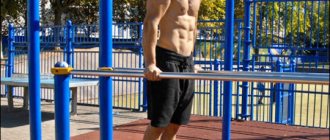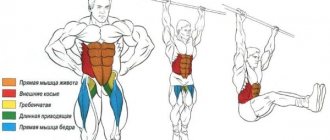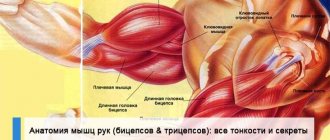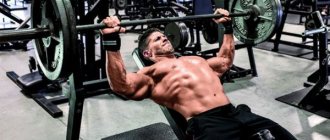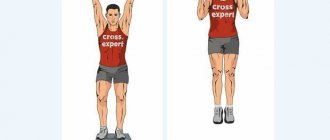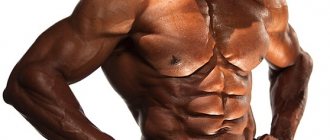What does the bars give? Horizontal bar and parallel bars - what will they give?
Many bodybuilders ignore exercises on parallel bars and the horizontal bar, citing either a lack of training time or the imaginary pointlessness of performing exercises where the maximum weight is equal to your own. In fact, both postulates are wrong. There may not be enough time for auxiliary and isolating exercises, those that are performed at the end of the workout.
Pull-ups on the horizontal bar, as well as push-ups on the uneven bars, involve a large number of muscle groups, and therefore should always be performed one of the first, and cannot be isolating. They are good at gaining mass, increasing strength and endurance.
In addition, it is not at all necessary to do these exercises only with your own weight - it is enough to hang several disks on your belt. The following muscles can be worked on the horizontal bar: trapezius, latissimus, teres dorsi, biceps and forearm muscles, deltoids. This is one of the best exercises for developing shoulders, visually broadening them. On the uneven bars - triceps, chest, trapezius, back muscles.
A combination of dips and pull-ups in supersets strengthens the tendons of the elbow joints. In the event that you use pull-ups as a basic exercise for the latissimus dorsi muscles (wings), then in combination with barbell and dumbbell rows in an incline position, upper/lower block rows, just one exercise per week, 40-50 minutes, becomes sufficient for good strengthening of the upper back muscles. Moreover, if you give up pull-ups, then to achieve a similar result you will have to increase the training time by two or even three times.
Dips are recommended to be used in conjunction with the bench press to accelerate the growth of the pectoral muscles. To focus the load on them, and not on the triceps, the body is moved a little forward, and the bars themselves are spaced as wide as possible. The same goes for push-ups on uneven bars, but in a vertical “Rack” and on closely spaced bars, it cooperates well with the French press. As practice shows, the use of the above-described schemes of working with the horizontal bar and parallel bars accelerates the process of growth of muscle mass, as well as muscle strength and endurance by 15-35% compared to traditional methods.
For beginning bodybuilders, working on parallel bars and the horizontal bar will provide the necessary “Base” - a complex of strength, endurance and muscle volume necessary for effective work with additional weights. Such exercises will not take much time - only 40 minutes 3 times a week, but the rate of muscle mass gain when switching to training according to “Real” programs will initially be higher, compared to athletes who have not undergone such preliminary training, and there will be no fatigue or fatigue. These exercises are also recommended for use after certain injuries, when working with a barbell is prohibited. Thus, pull-ups and dips provide the athlete with the opportunity to return to normal training.
For bodybuilding enthusiasts, as well as all those who prefer to engage in physical education, daily exercises on the horizontal bar and uneven bars will give you strength and endurance. It has been noticed that daily pull-ups - only 50-70 times, you can use the “Ladder”, equal or random approaches in terms of the number of repetitions, after 2-3 months result in the formation of strong and resilient arm muscles (biceps and forearms), despite the fact that their volume have almost no effect.
Also, working on the horizontal bar and uneven bars can be an excellent method to warm up before training, if we are talking about pre-competition preparation for bodybuilding performances, when the athlete performs only isolation exercises for greater muscle detail. At the competitions themselves, immediately before the performance, the purpose is to pump blood into individual muscle groups. In powerlifting, pull-ups with all types of grip allow you to use muscle groups that are not affected by the standard training program, primarily the biceps.
What are the benefits of pull-ups on a horizontal bar?
By exercising on the horizontal bar, you give an effective and proper load to the heart and blood vessels; the respiratory system also takes an active part in the work. Such moderate, but daily cardio exercises on the horizontal bar will help develop the heart muscle, increase heart endurance, and normalize blood pressure and pulse.
Interesting materials:
How to bleach a white terry robe? How to bleach a white medical gown? How to bleach white rabbit fur? How to bleach white arctic fox fur? How to bleach a white blanket? How to bleach a white down jacket from yellowness? How to bleach a white down jacket? How to bleach a white gossamer down scarf? How to bleach a white work coat? How to bleach a white scarf?
Horizontal bar and parallel bars, which gives. Pull-up technique
This exercise should be performed smoothly, without jerking, choosing the optimal pace for you. It’s also not a good idea to descend sharply, nor should you excessively hinder the descent. When your body is at the lowest point, make sure that your arms at the elbow and shoulder joints are fully extended. Also remember about proper breathing: inhale as you lower and exhale as you pull yourself up to the bar. When doing pull-ups on the horizontal bar, it is important that your shoulders are level with the bar and your chin goes above the horizontal bar. You can also pull yourself up so that the back of your head, rather than your chin, touches the bars. This increases the load on the deltoids and, especially, the trapezius muscles. Professional athletes advise alternating approaches, performing exercises with different grips (direct, reverse, narrow, wide).
How to exercise on the horizontal bar correctly
Exercises on the crossbar primarily load the so-called traction muscle groups of the back, shoulders and arms. These are the latissimus, trapezius and longus dorsi muscles, deltoid muscles of the shoulders (delta), biceps.
The load can be distributed differently between them due to different types of grip. You can hold the bar with your palms facing you (reverse grip) and away from you (forward grip). The grip can also be narrow (shoulder-width apart or slightly narrower), medium (slightly wider than shoulder width) and wide (hands spread as far apart as possible). Street Workout uses everything, as well as a mixed grip: one palm facing you, one palm away from you, then the positions of the hands change.
A direct grip uses the back and deltoids to a greater extent, while a reverse grip additionally loads the biceps and abs. A narrow grip position works the arms and longus dorsi, a wide grip puts more stress on the latissimus and trapezius muscles, and a medium grip width uses a little of everything.
What do dips give you? How to do push-ups
For both beginners and experienced athletes, a warm-up is necessary before training. Pay special attention to warming up the shoulder girdle. The better the muscles are warmed up and stretched, the less risk of injury.
Start the exercise ONLY from the top point. Do not start climbing from the bottom point - this is very risky, because... the muscles are stretched and the body is relaxed. Starting from the top point, the muscles are contracted, tense and ready to work.
Starting position - movement starts from the top point
Select the width of your grip and firmly grasp the bars with your hands. The grip is straight, palms facing the body. Press your chin to your chest. Shift your weight from your feet to your hands. Cross your legs and roll your shoulders back.
Inhale and begin to lower slowly. The slower you lower, the more effectively and safely you will load your muscles. Descend to a depth that is comfortable for you. Bring your shoulder blades together. Don't slouch. Don't let your shoulders move up and down or back and forth.
Lowest point when doing dips
With each workout, the flexibility of the pectoral muscles and shoulder region improves, so each time try to go deeper, but to a comfortable point. Your task is to master the full amplitude, while at the bottom point the angle at the elbow is 90° or less (the position of the shoulders is at the level of the elbows or below).
You can linger slightly at the bottom point, feeling the stretching of the muscles, but there should be no relaxation, and then begin to rise powerfully as you exhale, but very smoothly and without jerking. The descent is slow, the ascent is fast, but at the same time smooth.
While lifting, do not try to raise your head or rotate it. This can cause injury. Do not allow your body to sway, control your torso position. To achieve this stabilization, strain your abdominal and buttock muscles as hard as you can, while working only with the strength of your arms.
The bars themselves can be completely parallel or V-shaped. For the comprehensive development of the shoulder girdle and increasing the strength of the working muscles, shift the emphasis to the chest or triceps. Work in one style for a while, then change your focus.
Correct training frequency
There are from 640 to 850 large, medium and small muscles in the human body (the number depends on the counting method). When doing pull-ups, the following are involved:
When figuring out how many times a day or a week it is better to do pull-ups on the horizontal bar in order to pump up your muscles, you need to take into account their recovery time. For large spinal muscles - at least 4 days, for trapezius - 3 or 4, for the arms themselves - at least a day. Therefore, the only thing that will happen if you pull yourself up every day with maximum effort is weakness.
Muscle growth does not occur during physical activity, but after it - when the body rests. No rest - no weight gain.
If after exercise the muscle pain is severe or your health is bothering you, you need to rest longer until the unpleasant symptoms disappear. How many pull-ups you need to do on the horizontal bar also depends on your preparation:
We can conclude that it is undesirable to practice every day on a simple horizontal bar and uneven bars. In addition, it is necessary to select the optimal schedule. First of all, they calculate how many times you need to pull yourself up per approach, the number of sets on the horizontal bar. For beginners, the number of repetitions can be reduced.
Source
What do the bars shake? How to pump up your chest on the uneven bars?
One of the most effective and at the same time simple, affordable exercise machines are parallel bars. What do parallel bars pump and how effective can training on such a sports equipment be? With the help of parallel bars, you can thoroughly pump up your entire upper body, the main thing is to be patient and have enough free time.
The benefits of parallel bars training
It has been proven that the bench press is a less effective exercise in terms of muscle load than the parallel bars. What do the bars swing? If we go back several decades, they acted as the basic exercise machine for pumping up the pectoral muscles. However, the development of the industry for the production of new types of sports equipment has somewhat reduced interest in this projectile.
Why did athletes decide to abandon simpler and at the same time effective strength exercises in favor of innovation? It's all about the reputation of parallel bars as one of the most dangerous exercise machines.
Generally speaking, for practicing on the uneven bars, neither insurance nor observers are required. Training perfectly develops the outer and lower areas of the pectoral muscles. Regular training on the uneven bars allows you to feel a noticeable effect in a very short time.
Muscles involved in parallel bars training
When practicing on the uneven bars, the following muscles work:
- chest;
- deltoid;
- triceps;
- latissimus muscles.
Features of the exercises
As noted above, it is the parallel bars that carry a considerable risk of injury. What such exercise machines pump up are the abs, pectoral muscles, biceps, triceps, as well as a whole host of other small muscles of the body. However, it is worth noting that you can only get injured on the uneven bars if you use the wrong technique for doing the exercises.
Before you begin active regular training on the uneven bars, you should familiarize yourself with the following requirements:
- It is necessary to start the lesson from the upper support, which allows the muscles to fully tone up and prepare for work.
- When lowering, the torso should be tilted slightly forward, because in a vertical position the main load will fall only on the triceps.
- Legs should be bent at the knees with ankles crossed. This approach to performing exercises greatly simplifies keeping the body in an inclined position.
- It is better to rest your chin on your chest, maintaining this position until the end of the approach.
- When lowering, bend your elbows until your wrist joint is in line with your armpits. In this case, it is necessary to carry out the descent slowly. Quick jerks when reaching the top position are fraught with injuries to the pectoral muscles.
- After taking a short pause while lowering, you must return to the starting position evenly and slowly.
Abs workout
What do dips do? Primarily the chest muscles. Despite this, parallel bars can be an excellent exercise machine for working your abdominal muscles. The most common exercise on the parallel bars for training the abs is the “corner”. The main task here is to rest your hands on the bars, lifting your knees up to your chest and lowering them down. During each approach, you should try to fix your knees in the upper position for some time. You can perform the “corner” exercise not only on the uneven bars, but also on the horizontal bar. However, it is the first option that is more powerful.
You can pump up your abs on parallel bars by lifting your legs. Despite the obvious simplicity of the exercise, it is quite difficult to do, especially without any preparation. To perform the exercise, it is enough to rest your hands on the bars while simultaneously raising both legs above the level of the bars, spreading them to the sides. If desired, this exercise can be somewhat diversified by alternately moving your legs in one direction or the other over the right and left crossbar.
Another effective exercise on the parallel bars for pumping up the abdominal muscles is raising the torso. To perform it, you need to sit on one of the bars, hooking your legs behind the other. Sitting on the uneven bars in this way, you should lower your torso as low as possible, trying not to sag in your back. As a result of proper execution, the abdominal muscles will always remain fully tense.
How to pump up your chest on the uneven bars?
Perhaps, parallel bars are the most effective way to thoroughly work out the muscle mass of the chest area. Push-ups on parallel bars are particularly simple, but the following conditions must be met:
- Before you start pumping up your chest on the uneven bars, you need to thoroughly warm up and warm up your muscles;
- before performing the next approach, you should rest for a few minutes, trying to completely relax the muscles;
- For chest pumping to be effective, the distance between the crossbars should be slightly greater than the width of the shoulders;
- to achieve noticeable results, you should exercise regularly;
- to avoid injury, you should ask a specialist about how to pump your chest on the uneven bars correctly;
- the number of repetitions in each approach should be at least 10-12 lowering and lifting.
Pumping triceps on parallel bars
To pump up your triceps on the parallel bars, you need to use the correct technique. The distance between the parallel crossbars must necessarily exceed the width of the shoulders, but only slightly. When performing parallel bars exercises with too much distance, there is a significant risk of injury to the shoulder girdle.
Triceps training on parallel bars begins with a position on straight arms. Next, the arms are lowered to the bottom position until the angle of the arms is about 90°. This is followed by a smooth rise to the starting position without unnecessary jerks. This is how the outer and medial heads of the triceps are effectively worked out.
Weight training
Only parallel bars can completely replace the chest press. What such exercises do has already been described above. In order for parallel bars training to become a basic exercise for working the core muscles, you should work with some weights. You can secure the loads on a special belt to the lower back, each time using more and more significant weight.
Before you begin weight training, you should work hard to perfect the technique of performing the necessary exercises. It is also extremely important to select the most comfortable grip.
Recovery
Every experienced athlete knows how important the recovery process plays in the process of growing muscle mass and achieving high results. If we talk about training on the uneven bars, experts recommend doing it no more often than every other day.
In order to thoroughly pump the muscles of the chest area, during the recovery period you should provide the body with a sufficient complex of nutrients and microelements useful for the development of muscle mass, while not forgetting about complete relaxation. By following all the above tips, you can get a really well-developed and attractive torso, beautiful pumped up arms, and clearly visible abdominal muscles without any extra work and grueling training.
Experts answer the question of whether it is possible to do pull-ups on the horizontal bar every day
Everyone knows that pull-ups are one of the most effective ways to develop pronounced muscle definition in the torso and arms. But the question of whether it is possible to do pull-ups on the horizontal bar every day is a closely guarded secret for many - at least, it is asked regularly on thematic forums. Therefore, we decided to tell you how to use the horizontal bar correctly, what number of repetitions is optimal and how to achieve maximum endurance. If you are interested in finding out whether you can do pull-ups on the horizontal bar every day, then stay on this page. And after reading this article, you will be able to defend your dissertation on this current topic!
What do the bars give? What muscles work when exercising on parallel bars?
Parallel bars exercises are a simple and proven way to train a wide variety of muscle groups. This equipment is available in most gyms. When used correctly, parallel bars make it possible to pump up muscles no worse than is possible on weight machines.
Instructions
- 1 Exercises using parallel bars are aimed at developing a variety of muscle groups. Exercises on this apparatus contribute to the formation of the muscles of the chest, back, and shoulder girdle. Bars make it possible to perfectly pump up the muscles of the arms and abdominals. In this case, the main load still falls on the deltoids and triceps. Certain types of exercises develop the latissimus dorsi and lower chest muscles well.
- 2 An indispensable condition for creating a beautiful arm relief is well-developed triceps. Beginning athletes often forget about this, focusing on training the biceps, which does not contribute to building a harmoniously built figure. Dips effectively work the triceps, helping to build powerful muscles in this part of the arms.
- 3 A subject of special pride for any athlete is well-developed deltoid muscles. But it is quite difficult to form them on strength training machines. And here the bars come to the rescue. By choosing a set of exercises for these muscles, in a few months you will be able to boast of broad shoulders. Having mastered parallel bars exercises, it is usually easier for an athlete to move on to training the deltoid muscles using barbells and dumbbells.
- 4 One of the best exercises for shaping the lower chest is considered to be push-ups. In this case, it is recommended to move the lower part of the body back and lower the chin, pressing it to the chest. By changing the distance between the bars, you can consistently work out different bundles of the pectoral muscles.
- 5 Bars also provide ample opportunities for working out the abdominals. Raising and holding straight legs in a support position on the parallel bars is just one of the exercises for developing the abdominal muscles. Athletes also widely use lifting their legs bent at the knees, as well as spreading their legs over parallel bars to the sides.
- 6 A well-designed parallel bars training program can easily replace strength training with free weights, such as incline presses, dumbbell exercises and bench presses. To perform sets of exercises on the uneven bars, you do not need expensive equipment, because this apparatus can often be found on the most ordinary courtyard sports ground. The main thing when practicing is to show desire, determination and perseverance.
Secrets of proper use of parallel bars
The frequency of parallel bars training depends on several factors: the degree of your preparedness, the purpose of the training and the presence or absence of contraindications. The set of exercises for beginners is designed for 3-4 weeks with a training frequency of 2-3 times a week. It prepares the main muscle groups and joints of the shoulders, elbows and wrists for upcoming loads, teaches you to correctly distribute body weight on your arms and monitor your breathing.
You should not force things and try to immediately perform push-ups or pull-ups - you risk getting a sprain or joint injury. To begin with, the introductory exercises indicated in the description of the complex will be quite sufficient. In the future, it will be possible to increase the load by following the recommendations of professionals.
If you do not experience fatigue or muscle pain after training, you can increase the number of exercises to 4-5 times a week. A break from exercise is necessary to give the muscles a chance to recover. It is advisable to set aside at least one day a week for this.
For regular exercise to be beneficial, you need to know the following:
Advanced athletes perform a set of exercises on the uneven bars, consisting of regular and diagonal push-ups, reverse pull-ups, walking on hands, rotation, swing transitions, 4-5 times a week, supplementing them with training on the horizontal bar or horizontal ladder. If you wish, you can practice on the uneven bars every day, but in this case it is recommended to slightly reduce the number of exercises in the approaches and monitor the condition of the muscles after classes and the next day.
To perform training at home, universal 3-in-1 exercise machines are especially popular:
Source
Dips with weights
Many people ask about push-ups on parallel bars with weights, weights, and how to do them correctly so as not to injure the muscles and build muscles faster.
After all, everyone knows that on the uneven bars you can mainly pump up the pectoral muscles and triceps. So by using extra weight you can do it faster. In the article you will learn the best push-ups on uneven bars with weights, weights, how to perform them correctly and harmlessly, how to breathe correctly and do approaches and repetitions. Today, not everyone can even do dips correctly without weights, so you should first learn how to do dips at least 20 times per set correctly. Fully lowering yourself to the stop and rising to your outstretched arms. Find out:.
Dips with weights
In order for push-ups on the uneven bars with weights to give results, you need to know that if you do push-ups on the uneven bars, leaning slightly forward, you will put more stress on the chest muscles, and if, on the contrary, you try to do push-ups while leaning back, you will pump up your triceps.
The first thing you need for push-ups on uneven bars with weights to produce results is to set a clear goal for yourself, write it on a piece of paper, put a date next to it and draw up a training plan. In your training plan, write down the schedule, sets, and repetitions. Find out:.
Dips with weights, weights - exercises
Simple push-ups
In order for push-ups on uneven bars with weights to begin to produce results, learn to do push-ups on uneven bars 20 times correctly, doing 3-5 approaches with a break of 2-3 minutes. Keep your back straight, lean either backwards or forwards to target specific muscles, or straight forward for even distribution.
Take light weight
Once you learn how to do push-ups correctly, you can begin to take on additional weight, but gradually increase it. Start with 3-5 kilograms. If special straps and weights are not available, you can take a backpack and hang it on your lower abdomen, adding books or other additional weight to the backpack. Find out:.
Dips with weights and weights - recommendations
To perform push-ups on uneven bars with weights correctly and not injure yourself, do training regularly 3-4 times a week. Also try to properly push up to the end while keeping your back as straight as possible. Breathe correctly and evenly during exercise. Inhale as you rise and exhale as you descend.
Also, in order for push-ups on uneven bars with weights to give even more results to your muscles, eat healthy and natural foods that contain more proteins and vitamins. These can be: fruits, vegetables, meat, fish, eggs, dairy products, cereals, legumes. You also need to drink 2-3 liters of water per day.
Secrets of proper use of parallel bars
The frequency of parallel bars training depends on several factors: the degree of your preparedness, the purpose of the training and the presence or absence of contraindications. The set of exercises for beginners is designed for 3-4 weeks with a training frequency of 2-3 times a week. It prepares the main muscle groups and joints of the shoulders, elbows and wrists for upcoming loads, teaches you to correctly distribute body weight on your arms and monitor your breathing.
You should not force things and try to immediately perform push-ups or pull-ups - you risk getting a sprain or joint injury. To begin with, the introductory exercises indicated in the description of the complex will be quite sufficient. In the future, it will be possible to increase the load by following the recommendations of professionals.
If you do not experience fatigue or muscle pain after training, you can increase the number of exercises to 4-5 times a week. A break from exercise is necessary to give the muscles a chance to recover. It is advisable to set aside at least one day a week for this.
For regular exercise to be beneficial, you need to know the following:
Advanced athletes perform a set of exercises on the uneven bars, consisting of regular and diagonal push-ups, reverse pull-ups, walking on hands, rotation, swing transitions, 4-5 times a week, supplementing them with training on the horizontal bar or horizontal ladder. If you wish, you can practice on the uneven bars every day, but in this case it is recommended to slightly reduce the number of exercises in the approaches and monitor the condition of the muscles after classes and the next day.
To perform training at home, universal 3-in-1 exercise machines are especially popular:
Classic parallel bars trainers:
5 minutes to read. .9k.
Beginning athletes often believe that the more they practice, the greater their progress. This is a wrong and even dangerous approach. Before you torment yourself with training, you need to figure out whether you can do pull-ups every day and how your body will react to the load. It is also important to ensure that the exercise is performed correctly. Then, instead of injury and disappointment, a noticeable result will appear.



